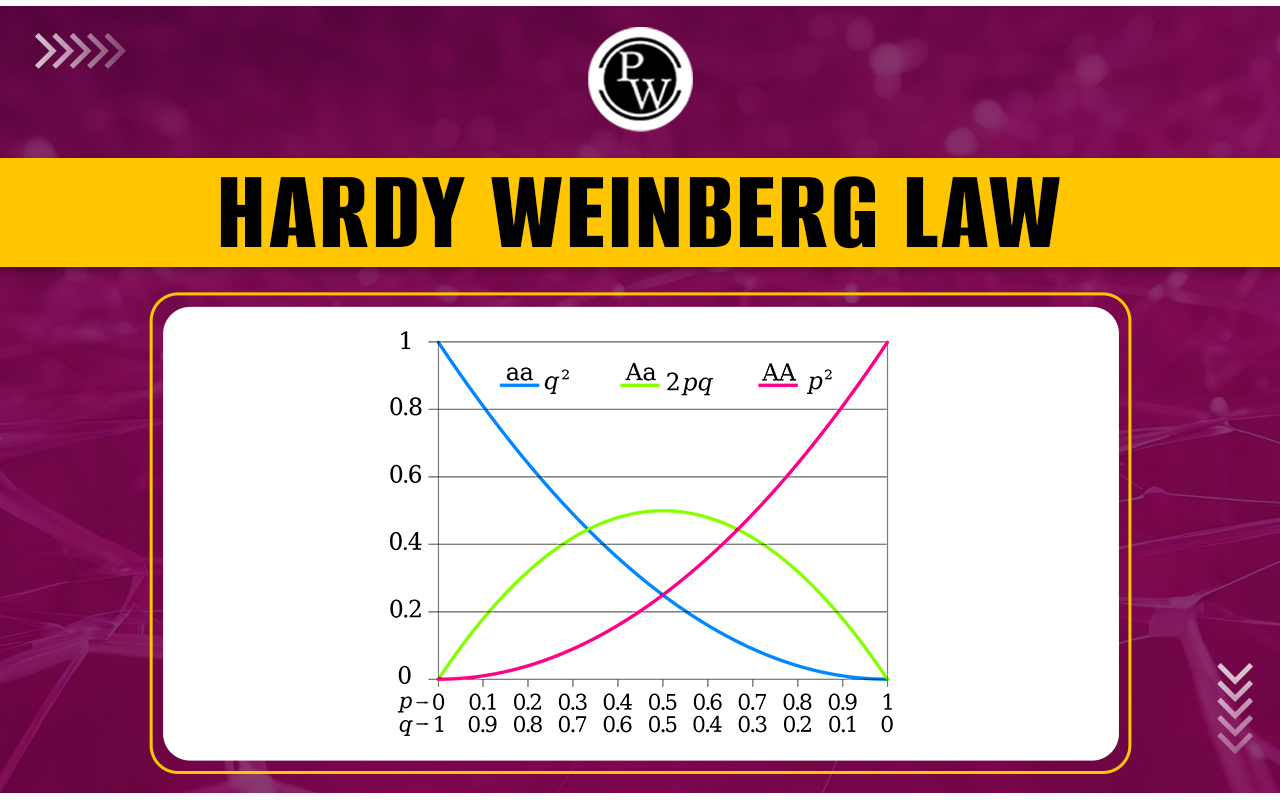

Hardy Weinberg Law: The Hardy-Weinberg equilibrium posits that genetic variation within a population remains stable across generations unless perturbed. It assumes random mating conditions, large population size, and no disruptive influences, thereby maintaining constant genotype and allele frequencies.
Mutations, natural selection, nonrandom mating, genetic drift, and gene flow all disrupt the equilibrium. Mutations introduce new alleles, altering frequencies, while natural selection and nonrandom mating shift gene frequencies based on differential reproductive success. Genetic drift causes random fluctuations in allele frequencies, predominantly in small populations, and gene flow introduces new alleles through inter-population breeding.
However, these disruptive factors are common in nature, rendering the Hardy-Weinberg equilibrium largely theoretical. It serves as an idealised framework for measuring genetic variations in real populations. NEET Biology Notes on the topic of Hardy Weinberg law is provided in the article below.
What is the Hardy-Weinberg Principle?
The Hardy-Weinberg Principle states that in a large population where individuals mate randomly, the frequencies of genotypes and alleles remain stable from one generation to the next unless evolutionary forces act upon them. These forces include selective mating, natural selection, genetic drift, mutation, sexual selection, gene flow, genetic hitchhiking, the founder effect, meiotic drive, population bottlenecks, inbreeding, and assortative mating.
The principle also explains that the frequencies of genotypes can be predicted through the binomial expansion of allele frequencies. If the frequencies of different alleles in a population are known, it is possible to calculate the expected frequencies of genotypes under certain assumptions.
Hardy Weinberg Law Equation
Consider a scenario involving a single genetic locus characterized by two alleles denoted as A and a, with respective frequencies represented by f(A) = p and f(a) = q. In this context, the expected genotype frequencies under the assumption of random mating within limited conditions are as follows:
- The frequency of AA homozygotes (f(AA)) is p².
- The frequency of aa homozygotes (f(aa)) is q².
- The frequency of heterozygotes (f(Aa)) is 2pq.
These frequencies are governed by the Hardy-Weinberg Equation, which can be expressed as:
p² + q² + 2pq = 1
According to this equation, the sum of the frequencies of all possible genotypes at the locus equals 1, representing the entire gene pool of the population. Notably, the allele frequencies, p and q, remain stable over successive generations without evolutionary forces such as mutation, natural selection, genetic drift, etc. This stability leads to genetic equilibrium, where the population's genetic composition remains unchanged over time.
Hardy Weinberg Law Assumptions
The Hardy-Weinberg equilibrium is a theory that suggests allele frequencies in a population will stay the same over generations if certain conditions are met. These conditions include:
Large Population Size: In small populations, random changes in allele frequencies, known as genetic drift, can happen.
Random Mating: Individuals mate by chance, without any preferences that might favour certain genotypes.
No Selection: There is no natural selection favouring any specific genotype, allowing all genotypes equal opportunities for survival and reproduction.
No Mutations: No new alleles are being introduced into the population through mutations .
No Migration: No individuals are moving into or out of the population, keeping the gene pool stable.
If a population meets all these conditions, it is considered in Hardy-Weinberg equilibrium. This means the allele frequencies should not change from generation to generation. However, it is important to understand that these conditions are rarely all met in nature. Most populations experience some level of selection, mutation, migration, or genetic drift. Therefore, the Hardy-Weinberg equilibrium is a theoretical concept that studies how populations can evolve over time.
Significance of Hardy Weinberg Law
The Hardy-Weinberg Principle is a fundamental idea in population genetics that explains how the genetic composition of a population remains stable through generations under certain conditions.
Here are the key aspects of the Hardy-Weinberg Principle:
- Predicting Genetic Variation: This principle is a benchmark for measuring genetic variation in a perfect population scenario. Scientists can spot differences by comparing the actual genetic make-up of a population to what is expected if the Hardy-Weinberg conditions are met. These differences help identify evolutionary forces acting on the population.
- Understanding Evolution: The principle provides a basic framework for understanding how populations change over time. Any shift away from this equilibrium suggests that factors such as natural selection or genetic drift may be at work.
- Applications in Conservation: The Hardy-Weinberg Principle is used in conservation biology to check the genetic health of populations. A population with limited genetic diversity might be at higher risk from environmental changes or diseases.
It's important to note that the Hardy-Weinberg Principle is theoretical. Real-life populations often do not meet all its assumptions, such as having a large population size and random mating. However, it is still valuable for analysing genetic variation and detecting evolutionary processes.
Sexual Reproduction in Flowering Plants
Hardy Weinberg Law Applications
The Hardy-Weinberg Law, or Hardy-Weinberg Principle, is a foundational concept in population genetics. It was independently developed in 1908 by G.H. Hardy, a British mathematician, and Wilhelm Weinberg, a German physician. This principle provides a mathematical model describing how a population's genetic variations remain constant under ideal conditions. According to this law, the frequencies of alleles and genotypes in a sexually reproducing population stay stable across generations unless influenced by factors such as mutation, migration, genetic drift, or natural selection. The following are the applications of the Hardy-Weinberg Law:
- Estimating Genetic Variation
The Hardy-Weinberg Law is essential for assessing genetic variation within a population. Researchers use it to compare observed genotype frequencies with those predicted under equilibrium conditions to identify evolutionary influences on genetic diversity.
- Understanding Disease Prevalence
In the fields of medical genetics and epidemiology, this principle is used to estimate the prevalence of genetic disorders, especially those caused by recessive alleles. This information is crucial for public health planning and genetic counselling.
- Conservation Genetics
The principle helps determine the genetic health of endangered species. A population in Hardy-Weinberg Equilibrium is generally considered stable; deviations may signal problems like inbreeding or genetic bottlenecks that require corrective measures.
- Forensic Science
In forensic science, the Hardy-Weinberg Law estimates the probability of certain genetic profiles within a population. This is particularly useful in linking DNA samples from crime scenes to potential suspects and providing evidence in legal cases.
- Studying Migration Patterns
This law enables scientists to monitor changes in allele frequencies, which can indicate migration events introducing new genetic elements into a population.
- Testing Population Structure
Significant deviations from the equilibrium can indicate that mating within a population is not random, possibly due to geographical, social, or other barriers. This insight helps researchers study population structure.
The Hardy-Weinberg Law remains important in population genetics, helping scientists understand genetic stability and change. Its applications extend from evolutionary biology theories to practical uses in healthcare, conservation, and forensic science. Establishing a genetic frequency baseline it facilitates the detection and quantification of evolutionary forces, affirming its importance in genetic research.
Physics Wallah offers affordable and NEET Online Coaching, featuring multiple languages, experienced faculty, and live/recorded classes to help students excel in their NEET preparations. Enroll Now!
| NEET Exam Important Links | |
|---|---|
| NEET Biology Syllabus | NEET Biology Diagrams |
| NEET Biology MCQ | NEET Biology Chapter wise Weightage |
| NEET Biology Notes | NEET Previous Year Question papers |
Hardy Weinberg Law FAQs
What is the Hardy-Weinberg Principle?
What Does "No Gene Flow" Mean?
Why is the Hardy-Weinberg Principle Important?
Why is the Absence of Gene Flow Important to the Hardy-Weinberg Principle?












